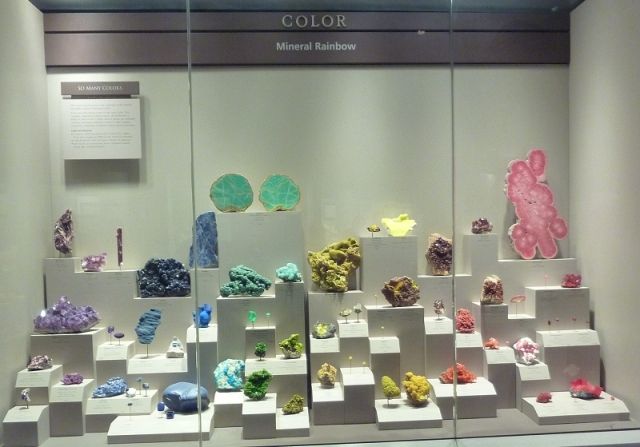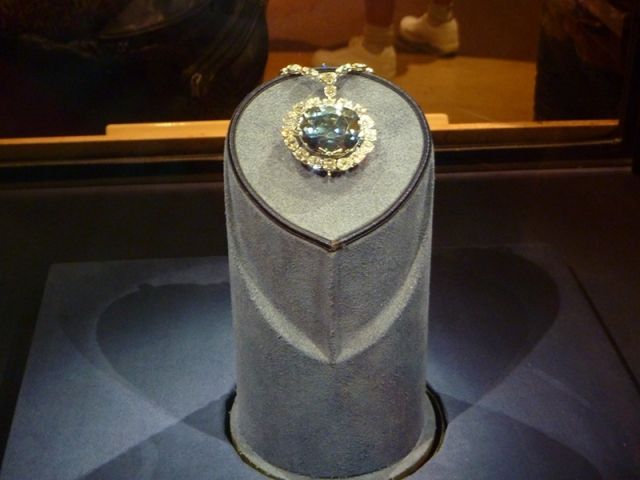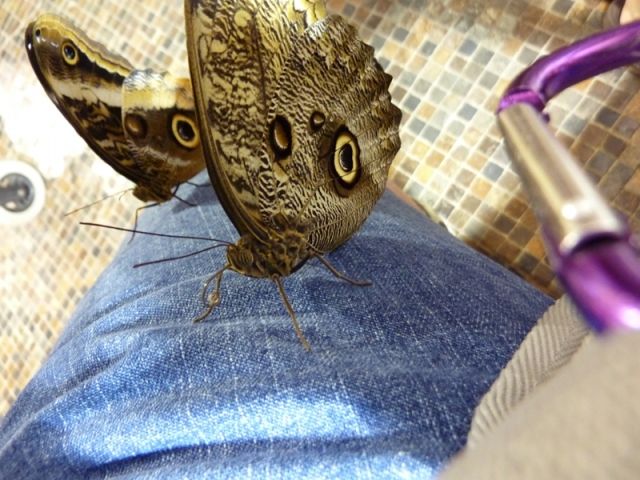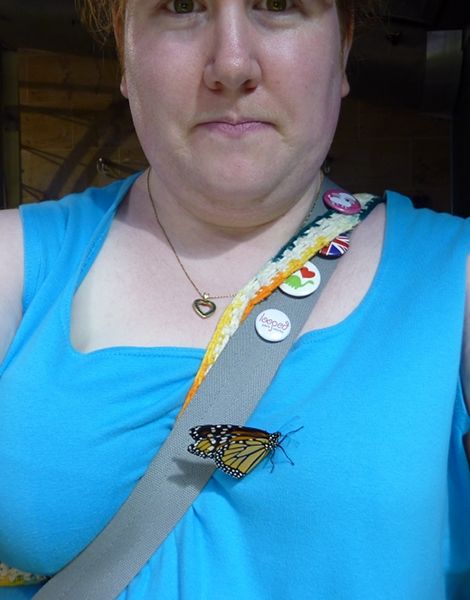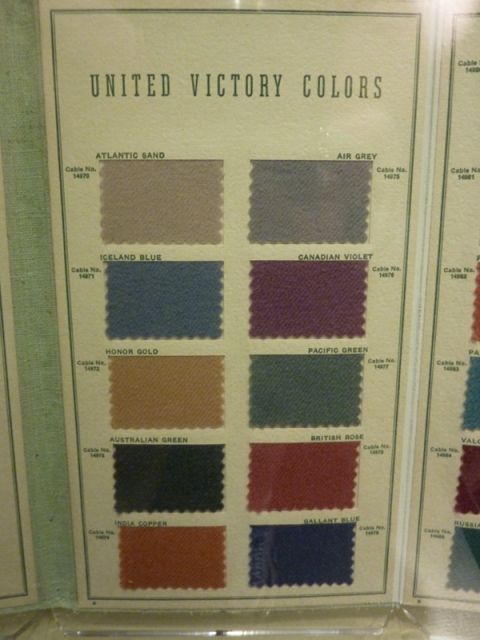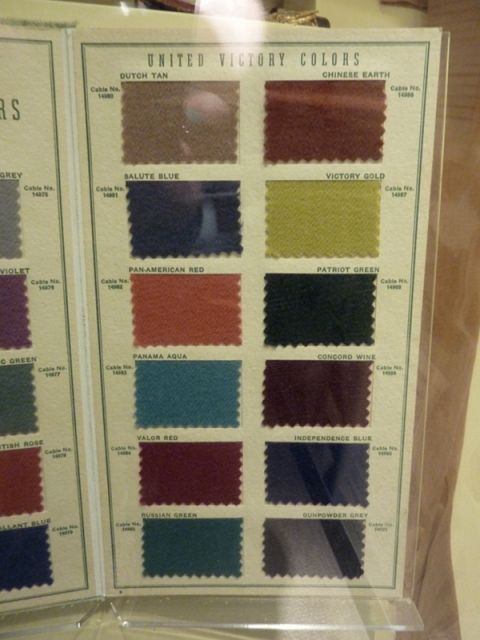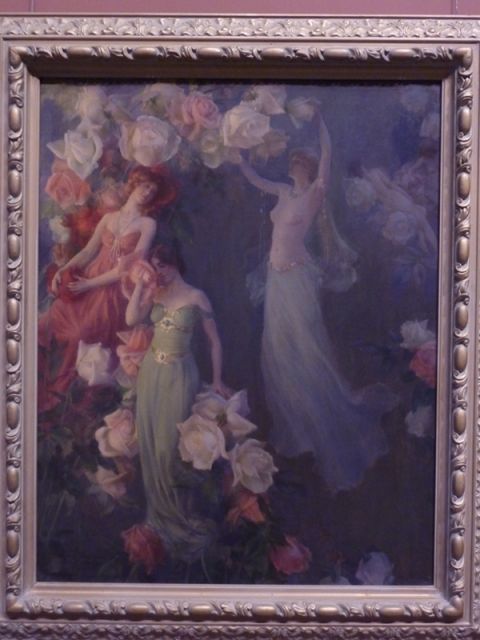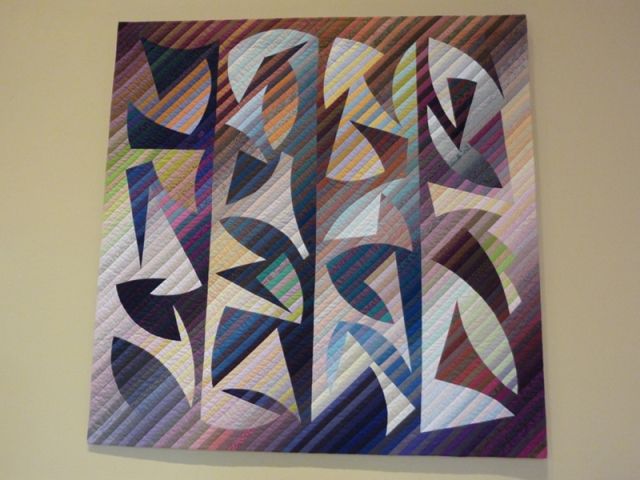I've gotten behind on my posting, and today's entry is about the National Museum of Natural History, which I visited almost two weeks ago. While there was a bit of art there, I'm not presenting it in this post, so this is another interlude in the Artsy Fartsy series.
Let me preface this post by telling you that when I was little, I had two basic passions in life: rocks and dinosaurs. It's a love that still lives on today. I've used dinosaurs in at least three of my art classes so far, and for the longest time you would not find me without a small, pleasing to the touch, rock in my pocket. So you can imagine how much in awe I was when I visited the Natural History Museum, and this was one of the first exhibits I saw:
The stegosaurus was always my second favorite dinosaur, because how could anything be better than the brontosaurus? (Even if it is a junior synonym for apatosaurus, brontosaurus is the favored term amongst most people I know, because we grew up with it. Also, it seems easier and more pleasing to say.) One of these days, I'll find my way to a museum that has a brontosaurus skeleton on display.
When I saw this next creature, my first thought was that it was a wampa from The Empire Strikes Back.
No, that's not the creature I saw, that's the wampa. This is the skeleton on display:
It's a giant ground sloth. They're extinct, so you have no worries about being able to reach your lightsaber to defend yourself from it.
Not all the animals I saw were dead, though. There was a very colorful exhibit of tropical fish. I wish I'd had a clicker to count how many people made Finding Nemo references when they saw this.
I took so many photos of rocks/gems/minerals that it was hard to decide what to include here, so I pulled out only the very best one.
A spectrum of rocks. Glorious to behold, isn't it? I think so, anyway. From there, I moved on to what is possibly one of the most famous gems in the world, the Hope diamond. You hear stories about how big it is, and how pretty, but I was vastly underwhelmed by it.
I was expecting something more along the lines of the Koh-i-Noor as seen in the Doctor Who episode "Tooth and Claw":
You can see in comparison why I was not impressed. What did impress me, though, was this perfect chunk of quartz which formed the largest crystal ball I've ever seen:
Perhaps the greatest lure of the Museum of Natural History, though, is the butterfly pavilion, which is free on Tuesdays. It's basically a sort of indoor greenhouse, filled with flowers and butterflies. You are assigned a specific time, and are allowed to stroll through and linger as you wish, watching the butterflies. Please don't touch them, though. The same rule doesn't apply to the butterflies, probably because they don't speak a human language, and they are allowed to touch you. These guys stayed on my shorts for probably half an hour. You can even see the proboscis of the closer one.
And one lovely Monarch decided to grace me with its presence as well. Hello there!
Next time we'll visit the National Zoo and the National Air & Space Museum.
Sunday, July 29, 2012
Monday, July 16, 2012
Artsy Fartsy, Part 4: National Museum of American History
I promised this last week, and I've finally gotten around to sorting through my pictures and paring them down to show you the ones that I like best. As such, and since the National Museum of American History is not an art museum, this post is less arty than others in the Artsy Fartsy series.
I have a feeling that this is the building that most people think of when they talk about "The Smithsonian" in general terms. It doesn't even begin to cover a fraction of everything that the Smithsonian holds, but is a good general overview of American history and culture in general.
If you're there at the right time, you can see (and maybe help with the unfolding/folding of) this giant replica of the Star Spangled Banner written about by Francis Scott Key. The entire building seems to stop for the singing of the national anthem. I have to admit, I'm not much of one for flag-waving, but it was a moving moment.
Some other truly American items on display are the hat that Lincoln wore the night he was shot,
Eisenhower's golf clubs (are those cozies just knitted, or both knitted and crocheted? I can't tell.),
and one of the first Teddy bears named for Teddy Roosevelt.
Something I found interesting was this display of swatches from the Textile Color Card Association of the United States, Inc. The Color Association does the same thing most people associate with Pantone these days, determining the "in" colors.
And keeping with the theme of textiles, this swift from the 1800s is made of ivory and bone, and doesn't appear to be much different from the wooden umbrella swifts of today. Why tamper with what works?
American History doesn't have to mean it's only about things you learn in history class. Pop culture can also have a historical relevance. I bet anyone could tell me whose shoes these are, after all, and the film they were used in was made 73 years ago.
And is there any American under the age of 45 who didn't grow up with this guy?
I think the biggest indicator of change and development in technology and culture in the last 140 years can be summed up in this picture. How much more is the object on the left capable of than the one on the right, and how many more people are aware of it than of its antique predecessor, yet how much more impact did the original model have on the world?
Now, I just have to decide which branch of the Smithsonian I want to visit next. Let me consult my iPhone...
I have a feeling that this is the building that most people think of when they talk about "The Smithsonian" in general terms. It doesn't even begin to cover a fraction of everything that the Smithsonian holds, but is a good general overview of American history and culture in general.
If you're there at the right time, you can see (and maybe help with the unfolding/folding of) this giant replica of the Star Spangled Banner written about by Francis Scott Key. The entire building seems to stop for the singing of the national anthem. I have to admit, I'm not much of one for flag-waving, but it was a moving moment.
Some other truly American items on display are the hat that Lincoln wore the night he was shot,
Eisenhower's golf clubs (are those cozies just knitted, or both knitted and crocheted? I can't tell.),
and one of the first Teddy bears named for Teddy Roosevelt.
Something I found interesting was this display of swatches from the Textile Color Card Association of the United States, Inc. The Color Association does the same thing most people associate with Pantone these days, determining the "in" colors.
And keeping with the theme of textiles, this swift from the 1800s is made of ivory and bone, and doesn't appear to be much different from the wooden umbrella swifts of today. Why tamper with what works?
American History doesn't have to mean it's only about things you learn in history class. Pop culture can also have a historical relevance. I bet anyone could tell me whose shoes these are, after all, and the film they were used in was made 73 years ago.
And is there any American under the age of 45 who didn't grow up with this guy?
I think the biggest indicator of change and development in technology and culture in the last 140 years can be summed up in this picture. How much more is the object on the left capable of than the one on the right, and how many more people are aware of it than of its antique predecessor, yet how much more impact did the original model have on the world?
Now, I just have to decide which branch of the Smithsonian I want to visit next. Let me consult my iPhone...
Friday, July 13, 2012
Artsy Fartsy Interlude: Washington, D.C.
I said my next post was going to be about the National Museum of American History, but I haven't been able to pare down the photos and decide what's worthy of showing, so I'm bringing you this interlude instead.
The last time I was in D.C. was in 1998, and a good portion of the pictures that were supposed to come home with us got fried by the X-ray machine at the J. Edgar Hoover FBI building. I'm still angry about that. FBI, you owe my mother a new camera. Hers never worked properly after that.
So I wandered around D.C. a little bit between museums yesterday, and got some photos of famous landmarks. If you've seen them before (and I'm sure you have) they're nothing special, but this is my blog and I can show you whatever I like.
The four pictures below were all taken from the same spot, but at 90º turns. The first three of them were taken at the same level of zoom, and the last one was without any zoom at all.
To the south, the Jefferson Memorial.
To the west, the Lincoln Memorial and Reflecting Pool.
To the north, the White House.
And to the east, the Washington Monument.
I tried to get a good picture of the Capitol Building, but it just wasn't happening yesterday. I still have a lot of sightseeing to do, though, so I'll get one eventually.
The last time I was in D.C. was in 1998, and a good portion of the pictures that were supposed to come home with us got fried by the X-ray machine at the J. Edgar Hoover FBI building. I'm still angry about that. FBI, you owe my mother a new camera. Hers never worked properly after that.
So I wandered around D.C. a little bit between museums yesterday, and got some photos of famous landmarks. If you've seen them before (and I'm sure you have) they're nothing special, but this is my blog and I can show you whatever I like.
The four pictures below were all taken from the same spot, but at 90º turns. The first three of them were taken at the same level of zoom, and the last one was without any zoom at all.
To the south, the Jefferson Memorial.
To the west, the Lincoln Memorial and Reflecting Pool.
To the north, the White House.
And to the east, the Washington Monument.
I tried to get a good picture of the Capitol Building, but it just wasn't happening yesterday. I still have a lot of sightseeing to do, though, so I'll get one eventually.
Thursday, July 12, 2012
Artsy Fartsy, Part 3: The Renwick
Today's trip took me to Washington, D.C., to the Renwick Gallery. It's the section of the Smithsonian that focuses on American Craft, which is where my interests lie. See? It even handily informs you of what it houses.
The lower level was unfortunately closed so that a new exhibit could be installed, but I did get to look around on the second floor and see some fascinating pieces.
The first room I entered was the Salon, and one of the pieces there almost immediately drew my attention. When I saw who the painter was, I was unsurprised that I liked it so much, as one of my very favorite paintings is by the same artist and hangs in the Parthenon in Nashville. This is The Perfume of Roses, by Charles Courtney Curran.
The next piece that grabbed me was the one below, by Wendell Castle. It is entirely made of wood. No, that is not a sheet on top of it. Entirely made of wood. Yes, really.
The Renwick seemed to have a higher ratio of textile and fiber-related art than the Walters or the BMA did, which I was pleased with. None of the pieces really stood out to me, though, other than this one by Michael James.
But quite possibly my favorite piece is the last one I'm going to show you. I saw it in a magazine just a few months ago and wondered how they'd stiffened the dress to stay in that shape so well. Imagine my surprise when I read the article and found that it was made of glass. I had a newfound appreciation for the medium of glass, thanks to Karen LaMonte, and I'm ever so pleased that I got to see it in person.
In my next post, I'll show you the highlights of my time at the National Museum of American History.
The lower level was unfortunately closed so that a new exhibit could be installed, but I did get to look around on the second floor and see some fascinating pieces.
The first room I entered was the Salon, and one of the pieces there almost immediately drew my attention. When I saw who the painter was, I was unsurprised that I liked it so much, as one of my very favorite paintings is by the same artist and hangs in the Parthenon in Nashville. This is The Perfume of Roses, by Charles Courtney Curran.
The next piece that grabbed me was the one below, by Wendell Castle. It is entirely made of wood. No, that is not a sheet on top of it. Entirely made of wood. Yes, really.
The Renwick seemed to have a higher ratio of textile and fiber-related art than the Walters or the BMA did, which I was pleased with. None of the pieces really stood out to me, though, other than this one by Michael James.
But quite possibly my favorite piece is the last one I'm going to show you. I saw it in a magazine just a few months ago and wondered how they'd stiffened the dress to stay in that shape so well. Imagine my surprise when I read the article and found that it was made of glass. I had a newfound appreciation for the medium of glass, thanks to Karen LaMonte, and I'm ever so pleased that I got to see it in person.
In my next post, I'll show you the highlights of my time at the National Museum of American History.
Subscribe to:
Posts (Atom)





